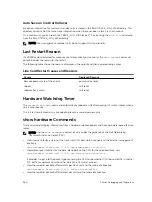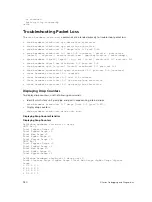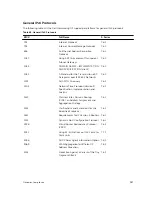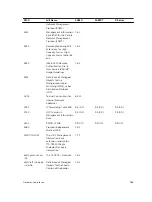
• Enable RPM core dumps and specify the shutdown mode.
CONFIGURATION mode
logging coredump server
When you enable this command to allow the system to automatically upload application core dumps to
an FTP server, you are required to enter a password. Use the password of the FTP server where the core
files are being moved. The password can be up to 15 alphanumeric characters only; no special characters
are allowed. After you enter the password, an FTP URL is created with the credentials in the operating
system. The CLI monitors application core dumps in the unit. Any application core dumps that occur are
automatically uploaded to the FTP server.
To undo this command, use the
no logging coredump server
command.
Mini Core Dumps
Dell Networking OS supports mini core dumps for kernel crashes. The mini core dump applies to Master
units.
Kernel mini core dumps are always enabled. The mini core dumps contain the stack space and some
other very minimal information that can be used to debug a crash. These files are small files and are
written into flash until space is exhausted. When the flash is full, the write process is stopped.
A mini core dump contains critical information in the event of a crash. Mini core dump files are located in
flash://CORE_DUMP_DIR
directory. The kernel mini core filename format is
f10StkUnit<stack_unit_no>.kcore.mini.txt
.
The panic string contains key information regarding the crash. Several panic string types exist, and they
are displayed in regular english text to enable easier understanding of the crash cause.
Example of a Mini Core Text File
VALID MAGIC
------------------------PANIC STRING -----------------
panic string is : <null>
----------------------STACK TRACE START---------------
0035d60c <f10_s0x120>:
00274f8c <panic+0x144>:
0024e2b0 <db0x134>:
0024dee8 <db_0x258>:
0024d9c4 <db_comma0xc4>:
002522b0 <0x158>:
0026a8d0 <mi0x1b0>:
0026a00c <bpendtsleep>:
------------------------STACK TRACE END----------------
---------------------------FREE MEMORY---------------
uvmexp.free = 0x2312
Enabling TCP Dumps
TCP dump captures CPU bound control plane traffic to improve troubleshooting and system
manageability.
When you enable TCP dumps, a dump captures all the packets on the local CPU, as specified in the CLI.
You can save the traffic capture files to flash, to FTP, SCP, or TFTP. The files saved on the flash are located
in the
flash://TCP_DUMP_DIR/Tcpdump_<time_stamp_dir>/
directory and are labeled
tcpdump_*.pcap
.
There can be up to 20
tcpdump_<time_stamp_dir>
directories. The file after 20 overwrites the oldest
Z-Series Debugging and Diagnostics
953
Summary of Contents for Z9000
Page 1: ...Dell Configuration Guide for the Z9000 System 9 7 0 0 ...
Page 80: ...grub reboot 80 Management ...
Page 128: ... 0 Te 1 1 Te 1 2 rx Flow N A N A 128 Access Control Lists ACLs ...
Page 491: ...Figure 70 Configuring OSPF and BGP for MSDP Multicast Source Discovery Protocol MSDP 491 ...
Page 496: ...Figure 73 MSDP Default Peer Scenario 1 496 Multicast Source Discovery Protocol MSDP ...
Page 497: ...Figure 74 MSDP Default Peer Scenario 2 Multicast Source Discovery Protocol MSDP 497 ...
Page 498: ...Figure 75 MSDP Default Peer Scenario 3 498 Multicast Source Discovery Protocol MSDP ...
Page 760: ...Figure 100 Single and Double Tag TPID Match 760 Service Provider Bridging ...
Page 761: ...Figure 101 Single and Double Tag First byte TPID Match Service Provider Bridging 761 ...
















































